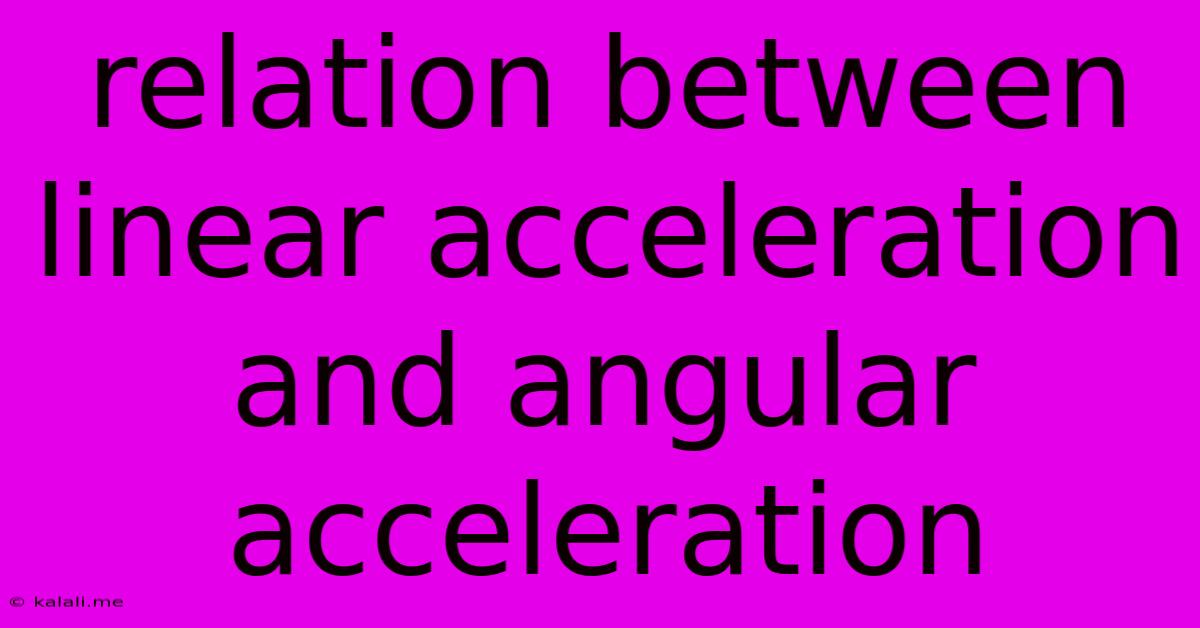Relation Between Linear Acceleration And Angular Acceleration
Kalali
Jun 14, 2025 · 3 min read

Table of Contents
The Intimate Dance of Linear and Angular Acceleration: Understanding Their Interplay
Meta Description: Discover the fundamental relationship between linear and angular acceleration. This article explores the connection, provides clear explanations with examples, and clarifies the crucial role of radius in this dynamic duo.
Linear and angular acceleration, while seemingly distinct concepts in physics, are intimately intertwined, particularly in rotational motion. Understanding their relationship is crucial for comprehending the dynamics of rotating objects, from spinning tops to planetary orbits. This article delves into this connection, providing a clear and concise explanation, supported by illustrative examples.
Defining the Players: Linear and Angular Acceleration
Before exploring their relationship, let's define each term individually.
-
Linear Acceleration (a): This refers to the rate of change of an object's linear velocity. It's a vector quantity, meaning it has both magnitude (speeding up or slowing down) and direction. A car accelerating from a standstill experiences linear acceleration. The units are typically meters per second squared (m/s²).
-
Angular Acceleration (α): This represents the rate of change of an object's angular velocity (ω). Angular velocity describes how fast an object rotates, often measured in radians per second (rad/s). Angular acceleration, also a vector quantity, indicates how quickly the rotational speed changes. Think of a spinning wheel speeding up or slowing down; this is angular acceleration. Its units are typically radians per second squared (rad/s²).
The Connecting Bridge: Radius
The key to understanding the relationship between linear and angular acceleration lies in the radius (r) of the rotational motion. The radius is the distance from the axis of rotation to the point on the rotating object where we're measuring the linear acceleration.
The relationship is expressed by the following equation:
a = αr
This equation elegantly states that linear acceleration is directly proportional to both angular acceleration and the radius. A larger angular acceleration or a larger radius will result in a greater linear acceleration.
Illustrative Examples
Let's consider a few examples to solidify our understanding:
-
A Merry-Go-Round: Imagine a child sitting on a merry-go-round. As the merry-go-round speeds up (positive angular acceleration), the child experiences an increasing linear acceleration, tangential to the circular path. The further the child sits from the center (larger radius), the greater their linear acceleration.
-
A Spinning Wheel: A wheel spinning at a constant angular velocity has zero angular acceleration. Consequently, any point on the wheel's rim also experiences zero linear acceleration, despite having a constant linear speed.
-
A Car Turning a Corner: When a car turns a corner at a constant speed, it's experiencing angular acceleration because its direction of linear velocity is changing. This angular acceleration translates to a linear acceleration directed towards the center of the turn (centripetal acceleration).
Beyond the Basics: Considering Centripetal Acceleration
The equation a = αr primarily describes the tangential linear acceleration. However, in circular motion, we must also consider centripetal acceleration, which is always directed towards the center of the circle and is responsible for keeping the object moving in a circular path. Centripetal acceleration (ac) is given by:
ac = ω²r
While not directly related to angular acceleration in the same way tangential acceleration is, centripetal acceleration is essential for a complete understanding of the forces and accelerations acting on an object undergoing circular motion.
Conclusion: A Unified Perspective
Linear and angular acceleration are inextricably linked, especially in rotational mechanics. Understanding their relationship, particularly the role of the radius, is crucial for analyzing the motion of rotating objects in various contexts, from simple everyday scenarios to complex engineering applications. By appreciating this connection, we can gain a deeper understanding of the dynamics of the physical world around us.
Latest Posts
Latest Posts
-
Is Air A Compound Or A Mixture
Jun 14, 2025
-
Florida Southern College Acceptance Rate 2024
Jun 14, 2025
-
Which Of The Following Is Not A Unit Of Energy
Jun 14, 2025
-
How Many Right Angles In A Square
Jun 14, 2025
-
Write The Prime Factorization Of 75
Jun 14, 2025
Related Post
Thank you for visiting our website which covers about Relation Between Linear Acceleration And Angular Acceleration . We hope the information provided has been useful to you. Feel free to contact us if you have any questions or need further assistance. See you next time and don't miss to bookmark.